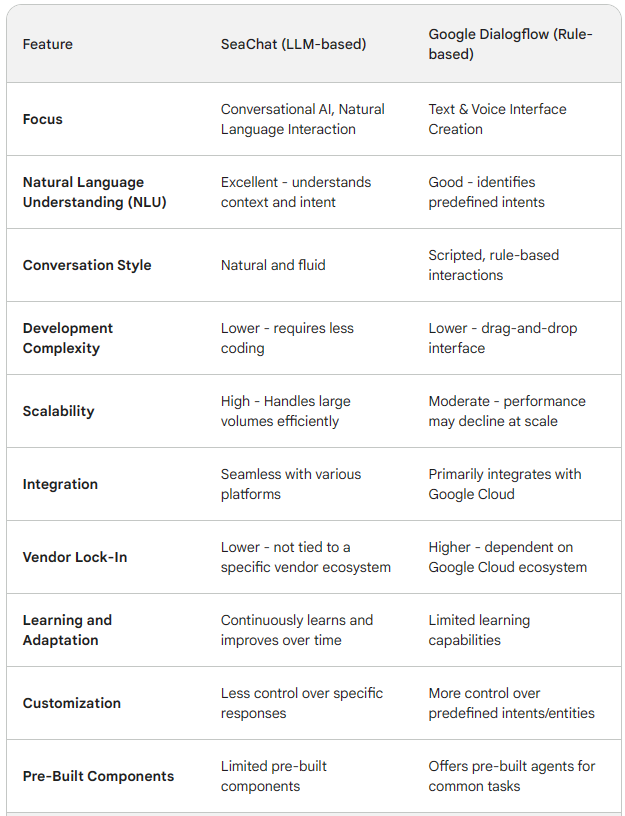The realm of Conversational AI is experiencing a surge of innovation. While Google Dialogflow has been a cornerstone for building interactive voice and text interfaces, a new wave of technology is making waves: Large Language Models (LLMs). SeaChat, a platform powered by LLM technology, presents a groundbreaking approach to Conversational AI, surpassing the capabilities of rule-based engines like Dialogflow. For organizations seeking to elevate their chatbot’s effectiveness and user experience, migrating to SeaChat might be a strategic move.
Google Dialogflow: A Well-Established Platform, But With Limitations
Dialogflow has established itself as a trusted platform for crafting chatbots. Its user-friendly interface and pre-built agents make it an attractive option for developers, particularly those new to building chatbots.
Here are some of Dialogflow’s strengths:
- Accessibility: The intuitive interface simplifies chatbot creation, allowing developers with less coding experience to get started quickly. This ease of use makes Dialogflow a popular choice for prototyping or small-scale projects.
- Pre-Built Components: Dialogflow offers a library of pre-built agents for common tasks, such as scheduling appointments or answering FAQs. This can significantly expedite the development process.
- Integration with Google Cloud: For organizations already invested in the Google Cloud ecosystem, Dialogflow’s seamless integration with other Google products streamlines development and data management.
However, as a chatbot’s functionalities mature and user expectations evolve, Dialogflow’s limitations become more apparent:
- Scripted Interactions: Dialogflow relies on predefined intents and entities, essentially forcing conversations down a rigid, pre-programmed path. This can lead to a stilted and unnatural user experience, failing to capture the nuances of natural language.
- Limited NLU Capabilities: wit.ai primarily relies on predefined intents, forcing conversations down a rigid path. This fails to capture the dynamic nature of spoken language.
- Scalability Concerns: Performance may decline when handling high volumes of user interactions, hindering growth potential.
SeaChat: Charting a Course for the Future of Conversational AI
SeaChat, powered by LLM technology, offers a paradigm shift in Conversational AI, propelling organizations beyond the limitations of rule-based engines:
- Advanced Natural Language Understanding (NLU): SeaChat excels at comprehending the subtleties of human language, enabling it to hold natural and context-driven conversations. Unlike Dialogflow’s scripted interactions, SeaChat can understand the intent behind a user’s query, even if it’s phrased in an unexpected way.
- Continuous Learning: SeaChat is a continuous learner, constantly evolving and adapting based on user interactions. This allows it to handle increasingly complex queries over time, ensuring your chatbot remains effective as your users' needs to become more sophisticated.
- Seamless User Experience: By understanding context and intent, SeaChat fosters a more natural flow of conversation, mimicking human interaction. This not only improves user satisfaction but can also lead to higher engagement and conversion rates.
Here’s why SeaChat can be a strategic advantage for your Conversational AI:
- Enhanced User Experience: Users crave chatbots that feel like talking to a real person. SeaChat’s advanced NLU capabilities, powered by LLMs, deliver on this promise, creating a more engaging and satisfying user experience.
- Reduced Development Time: Building chatbots with SeaChat often requires less coding compared to rule-based engines like Dialogflow. This allows development teams to focus on crafting the overall user experience rather than getting bogged down in the intricacies of intent definition and entity management.
- Scalability for Growth: SeaChat effortlessly handles large volumes of user interactions, ensuring smooth performance even during peak times. This makes it ideal for businesses that anticipate significant growth or experience unpredictable spikes in customer traffic.
A Feature Comparison: Dialogflow vs. SeaChat
Let’s delve deeper with a table to see how Dialogflow and SeaChat stack up:

SeaChat vs Google-DialogFlow
Study has shown the difference of intent/entity based NLU vs. LLM-based NLU is in the millions: in terms of training examples, it’s 630,000 examples versus a mere 32. This dramatic reduction in training data requirements translates to significant cost savings for businesses adopting GenAI/LLM-based NLU.
Setting Sail for a More Engaging Conversational Future
The future of Conversational AI lies in natural, engaging interactions. While Google Dialogflow has served its purpose, SeaChat offers a revolutionary approach powered by LLMs. Consider upgrading your chatbot to SeaChat for a more dynamic and human-like experience that will keep your users engaged and coming back for more. Let your chatbot ride the wave of the future with SeaChat!


 Subscribe
Subscribe